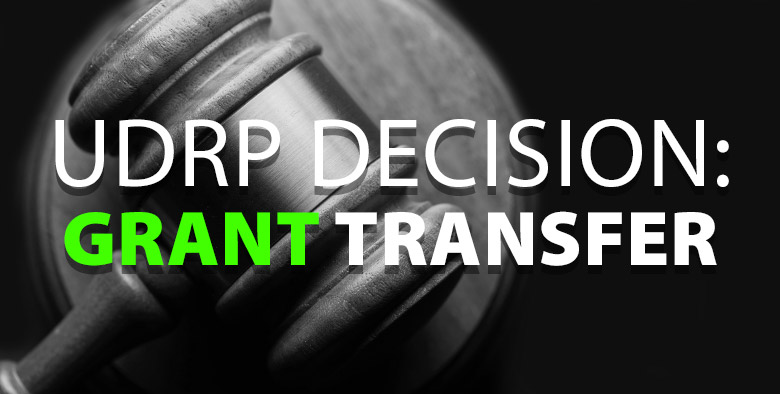Computer manufacturing giant, Dell, is known for its cheesy commercials in the early 2000s. These TV ads depicted Curtis as the “Dell Dude,” a teenage guy urging his buddies’ parents to get a Dell computer for their kids.
Dell filed a UDRP against the Chinese registrant of the domain name wwwDell.com.
Without doubt, this type of typo-squatting generated ample of type in traffic due to missing the dot after the “www.” The registrant pointed the domain to a scamming web site displaying fake virus attack messages.
Slam-dunk case for Dell, that won another UDRP recently as well; the NAF panelist ordered the domain wwwDell.com to be transferred to the Complainant.

Full details about this decision follow:
Copyright © 2025 DomainGang.com · All Rights Reserved.Dell Inc. v. Chun Yuan Jiang / JIANGCHUNYUAN
Claim Number: FA1909001864772
PARTIES
Complainant is Dell Inc. (“Complainant”), represented by Caitlin Costello, Virginia, USA. Respondent is Chun Yuan Jiang / JIANGCHUNYUAN (“Respondent”), China.
REGISTRAR AND DISPUTED DOMAIN NAME
The domain name at issue is <wwwdell.com>, registered with Alibaba Cloud Computing (Beijing) Co., Ltd..
PANEL
The undersigned certifies that he has acted independently and impartially and to the best of his knowledge has no known conflict in serving as Panelist in this proceeding.
Debrett G. Lyons as Panelist.
PROCEDURAL HISTORY
Complainant submitted a Complaint to the Forum electronically on September 30, 2019; the Forum received payment on September 30, 2019.
On October 8, 2019, Alibaba Cloud Computing (Beijing) Co., Ltd. confirmed by e-mail to the Forum that the <wwwdell.com> domain name is registered with Alibaba Cloud Computing (Beijing) Co., Ltd. and that Respondent is the current registrant of the name. Alibaba Cloud Computing (Beijing) Co., Ltd. has verified that Respondent is bound by the Alibaba Cloud Computing (Beijing) Co., Ltd. registration agreement and has thereby agreed to resolve domain disputes brought by third parties in accordance with ICANN’s Uniform Domain Name Dispute Resolution Policy (the “Policy”).
On October 11, 2019, the Forum served the Complaint and all Annexes, including a Written Notice of the Complaint, setting a deadline of October 31, 2019 by which Respondent could file a Response to the Complaint, via e-mail to all entities and persons listed on Respondent’s registration as technical, administrative, and billing contacts, and to postmaster@wwwdell.com. Also on October 11, 2019, the Written Notice of the Complaint, notifying Respondent of the e-mail addresses served and the deadline for a Response, was transmitted to Respondent via post and fax, to all entities and persons listed on Respondent’s registration as technical, administrative and billing contacts.
Having received no response from Respondent, the Forum transmitted to the parties a Notification of Respondent Default.
On November 1, 2019, pursuant to Complainant’s request to have the dispute decided by a single-member Panel, the Forum appointed Debrett G. Lyons as Panelist.
Having reviewed the communications records, the Administrative Panel (the “Panel”) finds that the Forum has discharged its responsibility under Paragraph 2(a) of the Rules for Uniform Domain Name Dispute Resolution Policy (the “Rules”) “to employ reasonably available means calculated to achieve actual notice to Respondent” through submission of Electronic and Written Notices, as defined in Rule 1 and Rule 2. Therefore, the Panel may issue its decision based on the documents submitted and in accordance with the ICANN Policy, ICANN Rules, the Forum’s Supplemental Rules and any rules and principles of law that the Panel deems applicable, without the benefit of any response from Respondent.
RELIEF SOUGHT
Complainant requests that the domain name be transferred from Respondent to Complainant.
PARTIES’ CONTENTIONS
A. Complainant
Complainant asserts trademark rights in DELL and alleges that the disputed domain name is confusingly similar to its trademark.
Complainant alleges that Respondent has no rights or legitimate interests in the disputed domain name.
Complainant alleges that Respondent registered and used the disputed domain name in bad faith.
B. Respondent
Respondent failed to submit a Response in this proceeding.
FINDINGS
The factual findings pertinent to the decision in this case are that:
1. Complainant manufactures and sells computers and computer equipment reference to the trademark DELL;
2. Complainant owns, inter alia, United States Patent and Trademark Office (“USPTO”) Trademark Reg. No. 1,860,272, registered October 25, 1994 for the trademark;
3. the disputed domain name was registered on September 5, 2013 and resolves to a website with revolving redirections to <givemethisoffice.com> or <mysecurify.com> or Complainant’s website; and
4. there is no commercial agreement between the parties and Complainant has not authorized Respondent to use its trademark or to register any domain name incorporating its trademark.
DISCUSSION
Paragraph 15(a) of the Rules instructs this Panel to “decide a complaint on the basis of the statements and documents submitted in accordance with the Policy, these Rules and any rules and principles of law that it deems applicable.”
PRELIMINARY ISSUE: LANGUAGE OF THE PROCEEDINGS
As a preliminary matter, the Panel notes the Chinese language Registration Agreement. Under Rule 11(a), the language of these proceedings is therefore Chinese. The Panel notes that Complainant has filed the Complainant in both Chinese and English. Given that there was no Response the Panel determines that the proceedings should continue in English and this Decision is therefore made in English.
Moving on, paragraph 4(a) of the Policy requires that Complainant must prove each of the following three elements to obtain an order that a domain name should be cancelled or transferred:
(1) the domain name registered by Respondent is identical or confusingly similar to a trademark or service mark in which Complainant has rights; and
(2) Respondent has no rights or legitimate interests in respect of the domain name; and
(3) the domain name has been registered and is being used in bad faith.
In view of Respondent’s failure to submit a response, the Panel shall decide this administrative proceeding based on Complainant’s undisputed representations pursuant to paragraphs 5(f), 14(a) and 15(a) of the Rules and draw such inferences it considers appropriate pursuant to paragraph 14(b) of the Rules. The Panel is entitled to accept all reasonable allegations and inferences set forth in the Complaint as true unless the evidence is clearly contradictory.[i]
Identical and/or Confusingly Similar
Paragraph 4(a)(i) of the Policy requires a two-fold enquiry—a threshold investigation into whether a complainant has rights in a trademark, followed by an assessment of whether the disputed domain name is identical or confusingly similar to that trademark.
Paragraph 4(a)(i) of the Policy does not distinguish between registered and unregistered trademark rights. It is well established by decisions under this Policy that a trademark registered with a national authority is evidence of trademark rights.[ii] Since Complainant provides evidence of its USPTO trademark registration the Panel is satisfied that it has rights.
The domain name takes the trademark and adds the non-distinctive abbreviation, “www””, together with the “.com” gTLD. The Panel finds the disputed domain name to be confusingly similar to Complainant’s trademark[iii] and so finds that Complainant has satisfied the requirements of paragraph 4(a)(i) of the Policy.
Rights or Legitimate Interests
Paragraph 4(c) of the Policy states that any of the following circumstances, in particular but without limitation, if found by the Panel to be proved, based on its evaluation of all evidence presented, shall demonstrate rights or legitimate interests to a domain name for purposes of paragraph 4(a)(ii) of the Policy:
(i) before any notice to you of the dispute, your use of, or demonstrable preparations to use, the domain name or a name corresponding to the domain name in connection with a bona fide offering of goods or services; or
(ii) you (as an individual, business, or other organization) have been commonly known by the domain name, even if you have acquired no trademark or service mark rights; or
(iii) you are making a legitimate noncommercial or fair use of the domain name, without intent for commercial gain to misleadingly divert consumers or to tarnish the trademark or service mark at issue.
Complainant need only make out a prima facie case that Respondent has no rights or legitimate interests in the disputed domain name, after which the onus shifts to Respondent to rebut that case by demonstrating those rights or interests.[iv]
The publicly available WHOIS information shielded the domain name holder but in consequence of these proceedings the name of the underlying registrant (Respondent) was disclosed. Neither provides any prima facie evidence that Respondent might be commonly known by the disputed domain name. There is no evidence that Respondent has any trademark rights and Complainant states that it has not given Respondent permission to use the trademark for any purpose. The use of the disputed domain name is as described above. Clearly, there has been no bona fide offering of goods or services nor a legitimate noncommercial or fair use of the domain name.
The Panel finds that Complainant has made a prima facie case. The onus shifts to Respondent to establish a legitimate interest in the domain name. In the absence of a Response, that prima facie case is not met and so Panel finds that Respondent has no rights or interests and so finds that Complainant has satisfied the second limb of the Policy.
Registration and Use in Bad Faith
Complainant must prove on the balance of probabilities both that the disputed domain name was registered and used in bad faith.
Further guidance on that requirement is found in paragraph 4(b) of the Policy, which sets out four circumstances, any one of which is taken to be evidence of the registration and use of a domain name in bad faith if established.
The four specified circumstances are:
(i) circumstances indicating that the respondent has registered or acquired the domain name primarily for the purpose of selling, renting, or otherwise transferring the domain name registration to the complainant who is the owner of the trademark or service mark or to a competitor of that complainant, for valuable consideration in excess of the respondent’s documented out-of-pocket costs directly related to the domain name; or
(ii) the respondent has registered the domain name in order to prevent the owner of the trademark or service mark from reflecting the mark in a corresponding domain name, provided that Respondent has engaged in a pattern of such conduct; or
(iii) the respondent has registered the domain name primarily for the purpose of disrupting the business of a competitor; or
(iv) by using the domain name, respondent has intentionally attempted to attract, for commercial gain, Internet users to respondent’s website or other on-line location, by creating a likelihood of confusion with the complainant’s mark as to the source, sponsorship, affiliation, or endorsement of the respondent’s website or location or of a product or service on the site or location.
On the evidence, the Panel finds bad faith under subparagraph (iv) above. The Panel has already found the disputed domain name to be confusingly similar to the trademark. There is no apparent reason for Respondent to register the name in good faith since the trademark appears to only refer to Complainant’s business and has no other shown meaning. In the absence of another explanation, the Panel finds that it is more likely than not that Respondent targeted Complainant trademark and business at the time of registration. The Panel finds registration in bad faith. Further, the Panel finds bad faith use since the revolving websites are likely to generate commercial gain for Respondent in one form or another.
The Panel finds registration and use of the domain name in bad faith and so finds that Complainant has satisfied the third and final element of the Policy.
DECISION
Having established all three elements required under the ICANN Policy, the Panel concludes that relief shall be GRANTED.
Accordingly, it is Ordered that the <wwwdell.com> domain name be TRANSFERRED from Respondent to Complainant.
Debrett G. Lyons, Panelist
Dated: November 3, 2019










